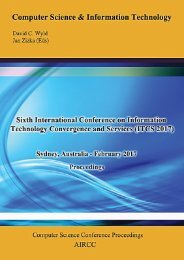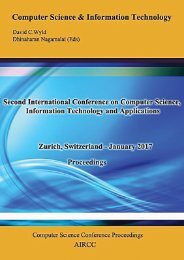CoSIT 2017
Fourth International Conference on Computer Science and Information Technology ( CoSIT 2017 ), Geneva, Switzerland - March 2017
Fourth International Conference on Computer Science and Information Technology ( CoSIT 2017 ), Geneva, Switzerland - March 2017
Create successful ePaper yourself
Turn your PDF publications into a flip-book with our unique Google optimized e-Paper software.
30 Computer Science & Information Technology (CS & IT)<br />
(HT) is a complex analytical signal processing technique [2]. This technique has been used to<br />
reconstruct the frequency signatures of the chipless tags. It has been experimentally proven that<br />
HT provides the extraction of the amplitude and phase functions of the frequency signature.<br />
The signal space representation of chipless RFID tags uses an efficient mathematical model to<br />
decode information in a chipless RFID tag [3-4]. The frequency signatures are represented by a<br />
matrix which is composed of orthonormal column vectors and a singular value matrix. The<br />
constellation of signal points are plotted with a basis function. It can be seen that as the number<br />
of bits increase this method will face limitations. Matrix pencil method (MPM) and Short time<br />
matrix principle method (STMPM) are two more detection techniques that have been applied for<br />
chipless RFID systems [5-6]. These two techniques are applied in the time domain and are<br />
mentioned as accurate detection techniques in extracting the carrier to noise ratio (CNR) of the<br />
response. Detection is performed by extracting the poles and residues from the backscattered<br />
signal using the Matrix Pencil Algorithm. A Maximum Likelihood (ML) based tag detection<br />
technique and Trellis decoding technique has been developed where detection error rate is<br />
compared with the bit to bit detection [7]. It has been found that ML detection has the best<br />
performance. It also reports that the computational complexity is higher in ML detection<br />
technique than Trellis detection technique.<br />
The main aim of this paper is to develop a detection algorithm which can be practically applied in<br />
firmware. As many of the above algorithms are highly complexed in implementing in the chipless<br />
RFID reader. Also, most of them have the limitation in the number of bits that can be detected. In<br />
this paper, we have developed a novel wavelet which suits the chipless RFID received signal to<br />
detect the frequency ID of the chipless RFID tag.<br />
2. SYSTEM MODEL AND DESIGN<br />
In this section the system model of the chipless RFID system used in this analysis is discussed. A<br />
description of the backscattered signal is also given and the backscattered signal of the used tag is<br />
analysed using simulation results obtained through CST microwave studio.<br />
2.1. Experimental Model<br />
Figure 1 –Chipless RFID system





